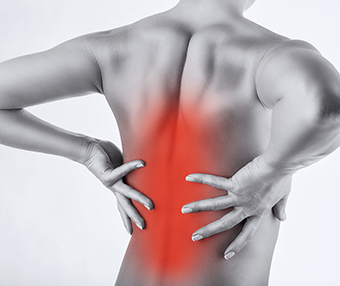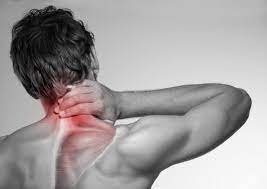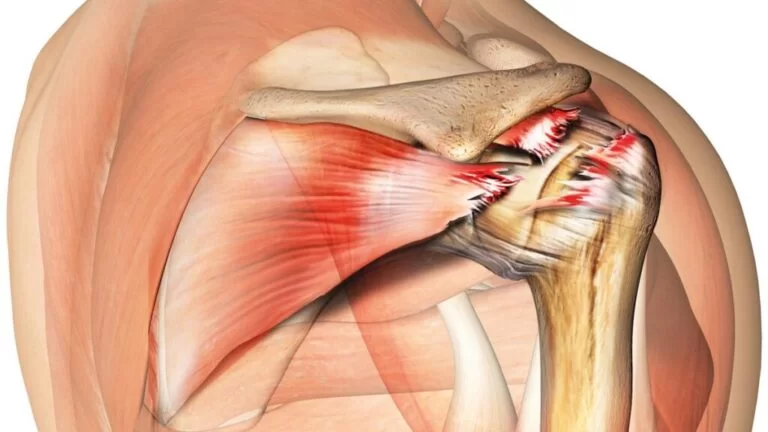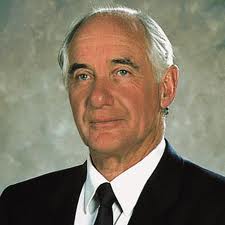Back spasm
A spasm in the back muscles is a common type of back pain. They may be tiny twinges or crippling contractions.
Home remedies like ice and heat can help, as can muscle relaxants, massages, stretches, and consistent exercise. Sometimes back spasms can Be a sign of a serious disorder and a Person may need to consult their doctor in the right way.
Table of Contents
What are back spasms?
- A Back spasm is when the human body muscles suddenly and against your will.
- They may painfully twinge, seize or contract.
- The muscles in the human body are divided into three parts upper back; intrinsic/deep muscle, middle back; superficial muscles, and lower back; intermediate muscles. Lower back spasms are most common, but any muscle can contract.
Causes of back spasms include:
Muscle overuse-
- Heavy lifting, repetitive movements (for example like, playing sports, and manual labor), and extended periods of physical activity without taking enough rest and recovery can inflame and injure back muscles.
Acute injury-
- A fall or sudden, abnormal twisting or bending movement may sprain or strain the muscles, tendons, or ligaments in the back.
- Poor posture-Inaccurate sitting or standing posture may put excessive strain on the muscles in the back.
Sedentary lifestyle-
- Insufficiency of regular physical activity may weaken the muscles in the back, abdomen, and buttocks and is associated with recurrent back pain.
Nutritional deficiency-
- Deficiencies in important vitamins and minerals — like; vitamin D, magnesium, and potassium — may disturb normal muscle function and cause back pain and spasms.
Anxiety and stress-
- Stress and anxiety may also cause spontaneous tightening of the muscles in the back and neck.
- Extended muscle tension may lead to muscle stiffness and spasms.
Disc disorders-
- Degenerative disc disease or a herniated disc may cause back spasms when the nearby muscles protectively tighten in an effort to immobilize the painful area.
Spondylolisthesis-
- A condition that creates a vertebra in the lumbar spine to slip out of its normal position.
- Some people with this type of condition experience back pain, stiffness, and muscle spasms.
Spinal stenosis-
- Narrowing of the spinal canal that squeezes the spinal cord and/or nerves.
- Pressure on the spinal nerves may also cause inflammation and muscle spasms.
Arthritis-
- The genesis of inflammatory arthritis that affects the spine, such as ankylosing spondylitis and osteoarthritis, may cause painful back spasms.
Fibromyalgia-
- A chronic condition distinguishes by widespread pain, including muscle spasms.
Symptoms of back spasms-
- A back spasm may experience a mild dull ache or twitch, or it may get so sharp and painful that it’s draining.
- If a person may feel any of the following symptoms in addition to back spasms, Persons should consult their doctor as soon as possible in a right way:
- Loss of bladder or bowel control.
- Muscle weakness in arms or legs.
- Odd sensations, numbness, or weakness on one side of a person’s body.
- Loss of balance and coordination.
- Sense of feeling in a limb/limbs may lost.
Muscle spasms are the most common in thoracic and lumbar muscles following;
Muscle Spasms of the Thoracic Spine-
- The trapezius is the wider muscle of the back and runs all the way from the person’s neck to the last vertebra of the person’s thoracic spine (mid-back).
- That means a spasm may not only affect the cervical part, but also the middle back muscles are also involved.
- Spasms in the thoracic area may also outcome from a contraction of the rhomboid muscle, which couple up the shoulder blades to the rib cage and spine.
- Most commonly, the muscles of the thoracic spine are the protected area of the spine, so there are less chances of spasm, compared to the cervical and lumbar region.
Causes of thoracic back spasm-
- Thoracic back pain may happen as an outcome of trauma or sudden injury, or it can occur through strain or poor posture over a period of time.
- Always includes the possibility of shingles, especially in older patients.
- The most common cause of thoracic back pain materialize to originate from muscular irritation or other soft tissue problems.
- These can appear from lack of strength, poor posture, prolonged sitting at a computer desk, using a backpack, overuse injuries (Like, repetitive motion), or trauma (Like, a whiplash injury caused by a car accident or as a outcome of a sports injury).
- Asymptomatic thoracic disc herniations are in proportion most common but symptomatic disc herniations are rare.
- They occur in roughly 5 in 1,000 disc herniations presenting in a clinical setting.
- The thoracic spine is relatively commonplace for inflammatory, degenerative, metabolic, infective, and neoplastic conditions.
- Thoracic back pain and dysfunction are associated with conditions like primary and secondary osteoporosis (vertebral fractures and hyperkyphosis arising from vertebral bone loss), ankylosing spondylitis, and osteoarthritis.
Symptoms of thoracic muscles spasm-
- If the patient has thoracic spine pain, these are the common symptoms to look out for:
- Feeling poorly – for example, a high temperature (fever), chills, and unexplained weight loss.
- The latest infection by a germ (bacterial infection).
- Pain that is getting severe and worsens all the time.
- Pain may not be caused by a sprain or strain (non-mechanical).
- Pain that doesn’t get cured after 2-4 weeks of treatment.
- Pain may be accompanied by severe stiffness in the morning.
- Changes to the shape of the spine, counting the appearance of lumps or bumps.
- Pins and needles, numbness or weakness in the legs that is severe or gets worse over a period of time.
- Passing wee or poo accidentally (indicates pressure on the spinal cord)
Muscle Spasms of the Lumbar Spine-
- A spasm in the lower back is likely a contraction of the erector spinal muscles, a large group of stabilizing muscles that run on either side of the spine, they are the largest muscle groups in the human body, covering the middle and lower back.
Lower back muscles spasm-
- Back spasms may be the result of injuries to the muscles, tendons, and ligaments in the back, or they can be allied to more serious medical conditions.
- Heavy lifting is the most common cause of back spasms.
- Moreover, heavy lifting or, any activities may put excessive strain on the muscles and ligaments in the lower back and can cause an injury.
- Sports like football and golf can lead to back spasms because they order the back to turn suddenly and repeatedly.
- A person’s back muscles may be more at risk if a person has weakened abdominal muscles, which help support the back.
- Weak or stiff muscles in the back itself may be injured more easily than muscles that are stronger and more limber.
- Back spasms may happen if a person has arthritis or a ruptured disc in the spine.
- Arthritis in the lower back may situate the pressure on the spinal cord, which may cause pain in the back and the legs.
- A damaged or bulging disc in the vertebrae can also pressure a nerve and result in back pain.
Lower back spasm symptoms-
- Muscle-related tension is the most common reason source of low back pain, most commonly in people with fibromyalgia.
- The potential of back spasm pain depends on a wide range of factors, related to how long a person has been experiencing the pain and their overall health.
- People may mark out back spasms as:
- Subtle muscle twinges
- A tight knot
- Sudden cramping that comes and goes
- Difficulty bending or moving
- Generalized weakness
Diagnosis of muscle spasm-
Unless a person can not move at all because of an injury, the doctor in all probability will test the patient’s range of motion, check how the nerves are working, and press on the back to zero in on the problem area. An individual may have blood and urine tests to find out other diseases, like an infection or a kidney stone.
- A doctor typically observe the diagnosis of the muscle spasm after considering the patient’s full history of symptoms and physical examination.
- The doctor may want to know about the onset of the pain, how long the muscle spasms last, and how recurrent they happen.
- Other necessary information may include which muscle or muscles are affected, whether the spasms happen consistently in the same muscles or affect various muscles, and the circumstances surrounding the spasms.
- Prevail a full personal and medical history (for example occupation, hobbies, history of genetic disorders) may help the doctor to rule out underlying factors and move to the muscle spasms inpatient.
Other tests-
Blood tests-
- If the patient’s medical history and physical examination are not enough to diagnose muscle spasms, the doctor suggest blood tests to check the patients’ level of sodium, potassium, calcium, and magnesium.
A creatine phosphokinase –
- CPK blood test can be used in diagnosis of muscle breakdown.
- CPK is released as a result of muscle damage, which may happen if muscle spasms are prolonged.
MRI-
- If there is a trouble for arteriosclerosis, imaging tests, such as ultrasound or magnetic resonance imaging (MRI), may ordered to assess the blood vessels for narrowing.
Ct scan-
- Computed tomography angiography which includes injecting dye into an artery near the groin or wrist, can also be used to assess blood flow in the arteries.
Treatment-
First aid–
- In the middle of a back spasm, gently make her way to the nearest comfortable chair or sofa.
- Here, you can try the following techniques to overcome the pain:
- Gently massage the spasm with the hand or using the massage gun. This may give temporary relief to spasms.
- As patient massage, the area, make sure that they should be mindful of their breathing. Take slow breathing to overcome stress-induced pain.
- Diaphragmatic breathing can help the patient to become calm down.
- Apply at once heat and ice in 15–20 minute intervals.
- If possible, try to look out for a comfortable lower back stretch, like Child’s Pose or a seated spinal twist. This requires the patient to stand up from the couch and get to the floor, so only proceed if you feel comfortable with these movements.
- Wrap ice packs in a towel to eschew ice burns, and give your skin a break after icing.
- Regular stretching helps an individual with chronic back pain, but for an acute back spasm, this may cause Trusted Source additional swelling to the affected area.
- The best treatment for the acute muscle spasm is to take for some rest, take it easy, and call the doctor if the pain gets worse.
Medical Intervention-
Non-steroidal anti-inflammatory drugs (NSAIDs)-
- such as Ibuprofen, will not give immediate relief, but it may help slow the spasm within 30–60 minutes.
Muscle relaxants-
- A doctor may determine muscle relaxants when a patient has severe spasms that are visible and prominent.
- People should only take muscle relaxants for up to 72 hours.
Water and electrolytes-
- Dehydration may cause muscle spasms, or make existing spasms severe.
- Carry on with drinking water, or review switching to an electrolyte drink.
Physical therapy treatment-
- It includes electrotherapy and exercise therapy techniques.
Electrotherapy-
- TENS and ultrasound are most commonly used to control pain and decrease muscle spasm
Exercise therapy –
- Acute spasms includes-Heat or ice application and massage techniques and stretching of specific muscles and strengthening in the progression period.
- Chronic spasms includes-Spinal manipulation techniques
Heat or ice-
- Both heat and ice may decrease the pain of a muscle spasm.
- Both treatments can decrease inflammation and ease muscle tension.
- Simultaneous hot and cold packs may be particularly helpful.
- first, try to apply hot and then cold packs for 20 minutes at one time, with a 20-minute break in between.
- Do not apply too hot or cold packs to the skin. Instead, muffle them in a towel or cloth before placing them against the back.
Massage-There are five different massage techniques to relieve back muscle spasms-
Effleurage–

- Described by long, sweeping strokes from the top to the bottom of the muscle.
Petrissage
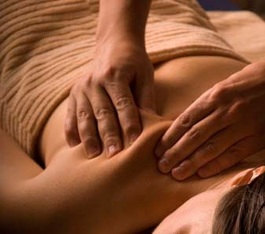
- It encompass rolling and kneading motions on the muscle.
- Pressure generally depends on the sensitivity of the patient.
- This technique mainly focuses on the tense area of the back.
- The massage therapist starts the Swedish massage with a light petrissage and slowly increases the pressure to release muscle tension.
Tapotement –
- This manners includes light and rhythmic tapping or drumming.
- The pressure and speed either relaxing or energizing.
Friction –

- The massage therapist may put it deep pressure to the affected muscle to release tension.
- Firm pressure on the affected muscle may help decrease the tension and stop the spasm.
Stretching- Here, a few stretches are recommended for back spasms;
Knee to Chest-

- This stretch may help to align the pelvis and stretch lower back muscles.
- Lie flat on her back with toes pointed towards the sky.
- Slowly bend her right knee and pull her leg up to her chest.
- Wrap your arms around your thigh, knee, or shin, and carefully pull the knee towards your chest.
- Hold for 20 seconds and gently extend the leg to starting position.
- Repeat three times for each leg.
Lying Knee Twist–
- This type of movement may help to stretch the paraspinal muscles and strengthen the abdominal muscles.
- Lie on her back with her legs extended straight out. Bend the right knee up and cross it over the left side of her body.
- Hold the position, this will help a person to feel a gentle stretch through the back and buttocks muscles for 20 seconds.
- Tighten her core muscles and rotate back to the center.
- Repeat three times on each side.
Yoga Cat/Cow–

- This position starts by kneeling on all fours with her hands beneath her shoulders and her knees directly below her hips.
- Exhale and gently arch her spine. Inhale, tighten the core muscles, and round her back, like a cat.
- Move slowly among movements and hold in each position for 5-10 seconds.
- Repeat 10 times.
Piriformis Seated Stretch–
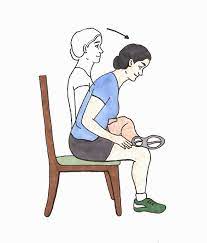
- This stretch helps to lengthen the piriformis muscle over a period of time.
- This muscle is most probably the reason for sciatica or radiating leg pain.
- Sitting with a straight back, cross her left leg over her right leg places her foot next to her thigh, and tucks her right leg in towards her buttocks.
- Place her right arm on her leg as pictured and slowly ease into a stretch.
- Make sure that her back becomes straight and her chest is lifted.
- Hold this position for 20 seconds and alternative sides, three times.
Cobra Stretch–

- This movement is helpful in tight abdominal muscles and the lower back.
- Begins by lying on her stomach with her legs extended and with palms planted on either side of her head with her forearms and elbows flat on the ground.
- Gently, push her body upwards, so her weight is resting on her forearms.
- Make sure that her hips are placed on the ground.
- Once you reach a comfortable position that gently stretches the abdominal muscles and lower back, hold for 10 seconds.
- Gently return to starting position and repeat it five times.
- If the person has more flexibility in their lower back, try straightening their arms.
Restful Pose–

- A common pose in yoga, the restful child’s pose may help the person to relax their body.
- Position yourself on the floor on hands and knees with her knees just wider than hip distance apart.
- Turn her toes in to touch and push her hips backward bending her knees.
- Once you reach a comfortable seated position, extend her arms forward fully and allow her head to fall forward into a relaxed position.
- Hold this pose for 20 seconds and gently return to starting position.
- Repeat three times.
- For modification, if a person has shoulder pain, place her arms on either side of her body, extending towards her feet.
Ergonomic advise-
- There are some tips that can help a person to relax their back pain when it happens.
- They can also help you prevent back pain in the first place.
Carry less-
- Heavy briefcases, laptop bags, suitcases, and purses may add some unnecessary stress and strain to her neck and spine.
- Try to reduce what you need to carry, and use bags that distribute the weight more equally, like as a backpack.
- If an individual can, use a bag with wheels to keep weight off your back entirely.
Working on core muscles-
- The muscles in and around a person’s abdomen and back help keep the person upright and carry them through their physical activities.
- Strengthening them may also reduce the chances of pain, strain, or damage to your back.
- Plug strength training workouts with a core focus into her regular fitness routine a few times a week.
Improve posture-
- Poor posture can put irrelevant pressure and strain on a person’s spine.
- Over time, this may lead Trusted Source to pain and damage.
- Frequently remind yourself to roll back rounded shoulders and sit upright in the chair.
Change shoes-
- High-heeled shoes are likely to cause Trusted Source damage to a person’s back if an individual wears them frequently.
- Choose comfortable, supportive, and minimally elevated-heeled shoes when you can.
Stretch often-
- Doing the same thing, every day may leave Trusted Source her muscles fatigued and more likely to strain.
- Stretching on a daily basis helps to improve circulation in those muscles and reduce the risk of back pain and damage
FAQ
Most episodes of back spasms last for only some days. In some severe cases last about six to eight weeks, but spasms and pain should be decreased gradually over that time period, allowing individuals to move freely and get back to their normal activity.
A spinal muscle spasm could act as something serious, like a micro tear around a spinal disc that may create enough inflammation to cause muscles to tense. In most cases, although, a muscle spasm in the back is a symptom of a mild muscle injury, such as a sprain.
Stretching decreases muscle tension and may stop muscle spasms. Lots of people experiencing sudden spasms are reluctant to move, but simply getting up and walking can help.
Massage may be a great way to relieve physical pain and muscle cramps. Slowly rub the muscle that is in spasm. For a persisting back spasm, try to pinch the area around it hard and hold the pinch for a few minutes.
If the pain person feels extends to their arms, forearms, and hands, the source can be the cervical spine. Additionally, if individuals feel the pain radiating to their legs, it can be a problem with the lumbar spine.

